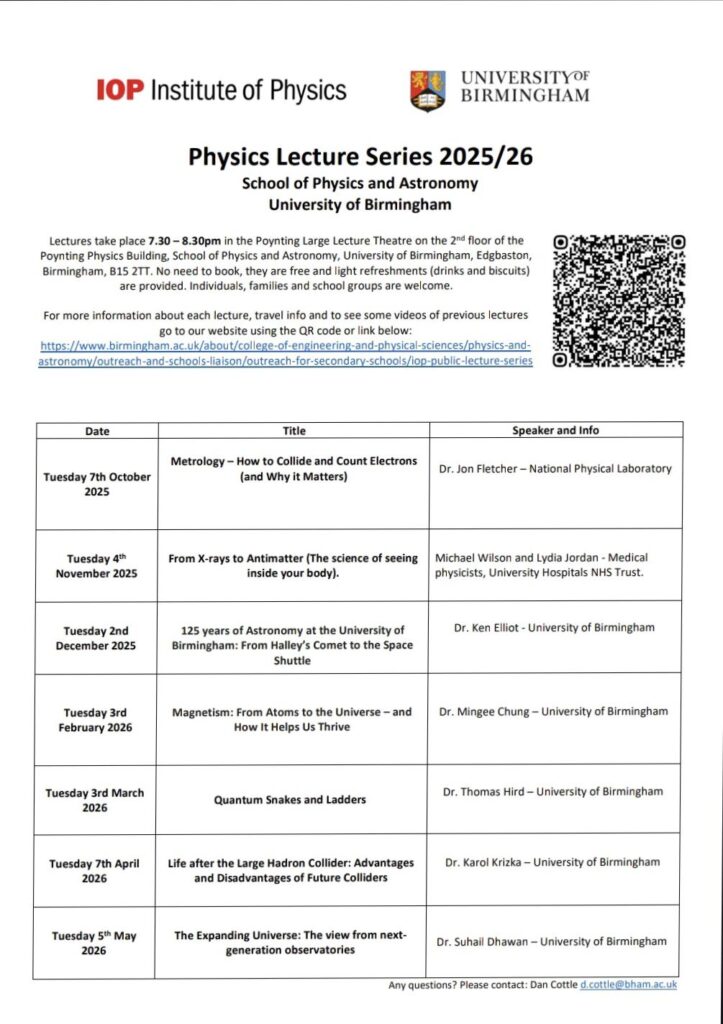The science department would like to share with you all another brilliant series of lectures that the Institute of Physics is hosting at the University of Birmingham this year. Last year, Cian and Patrick of 9S1 attended many of these and reported back how enlightening they are. Below is a write up about one of the lectures the pupils attended:
“On the 3 December 2024, me and a friend went to the University of Birmingham for the public physics lecture, led by Dr Anjali Piette. The topic was called ‘What’s the weather like on alien planets?’, and was about how weather works on different exoplanets, and how we can discover what different atmospheres are made of.
As we walked into the science department, we went upstairs and into the guest area. There were complimentary hot drinks, as well as mince pies for snacking on. At 7.30pm, we went into the lecture theatre and got seated. Dr Anjali Piette first discussed the James Webb Space Telescope (JWST), and how it launched on the 25 December 2021, at 12.20pm GMT. She discussed that our solar system has 8 planets: 4 are known as rocky planets, 4 are known as gas giants. We found out that every star has at least 1 exoplanet orbiting it. With this in mind, there must be hundreds of thousands of exoplanets in space.
We learnt that exoplanet S78S has a temperature range from as low as -175°c all the way up to 2000°c. We were also told that the first exoplanet to be discovered was called 51 PEGASI B, discovered in 1995. If you could see 51 PEGASI B from earth, it would be like looking at a tennis ball all the way on the moon!
For indirect detection methods, we can look at stars in deep space, and whenever the light from the stars will be fainter than usual, we can tell that an exoplanet is passing in front of the star. Sometimes it can take years to observe exoplanets, as the speed it takes for the planet to rotate its star can differ from other planets. Another way of indirectly observing an exoplanet is by looking at its star. Planets emit infrared light, which cannot be seen by the naked eye, whereas stars emit visible light, which is why they are visible at night. When an exoplanet passes behind the star, the star glows brighter under an infrared lens, as you can also see the light of the exoplanet.
We also discovered that to observe the elements in an exoplanet's atmosphere, we can go to a lab and see what elements absorb certain colours. If we find that carbon dioxide absorbs the colour red, we can use an advanced light sorter spectrum on the exoplanets light, and if a certain shade of red is not there, we know that there is carbon dioxide in the atmosphere.
Dr Anjali Piette began to discuss other exoplanets. She spoke about the planet WASP 18 B, and how it was like an ultra-hot Jupiter. WASP 18 B’s temperature can go as high as up to 2700°c, whereas Jupiter is at 110 °c. We can observe that there is water vapour on WASP 18 B, as there is a bump on the “fingerprint pattern”, which means that there is water vapour. This could indicate that there was water on this exoplanet, which could also be a sign that life could have once inhabited this planet, before its extreme temperatures.
As we came to the end of the lecture, we were handed QR codes, which led us to a survey. If we completed the survey, we were put into a prize draw to win a custom UOB umbrella. Unfortunately, I did not win, but I still had an enjoyable time.”




